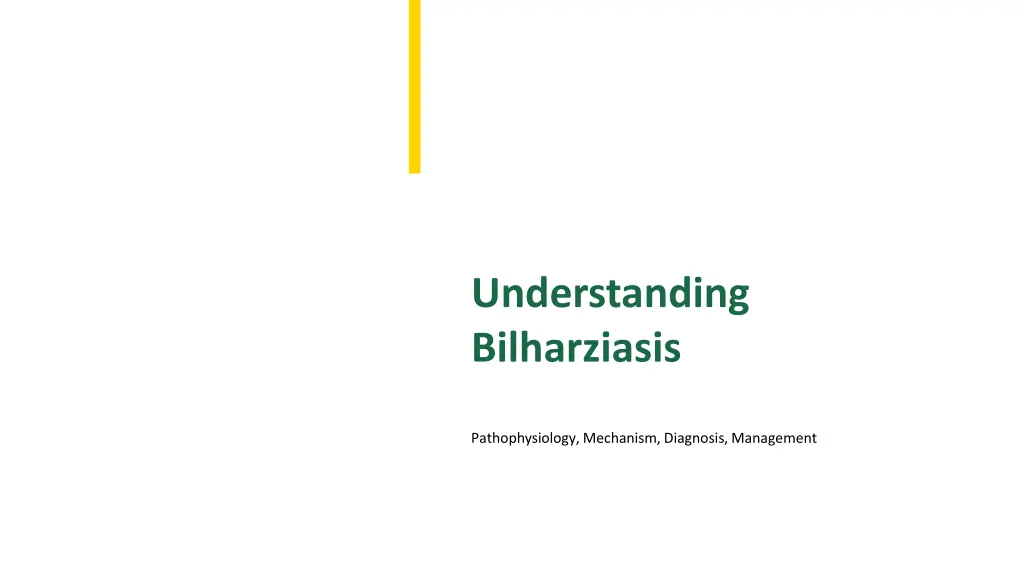
Understanding Bilharziasis: Pathophysiology, Mechanism, Diagnosis, Management
Explore the pathophysiology, mechanism, diagnosis, and management strategies of Bilharziasis, a tropical disease caused by parasitic worms. Learn about the impact on global health and the challenges faced in combating this silent threat.
Download Presentation

Please find below an Image/Link to download the presentation.
The content on the website is provided AS IS for your information and personal use only. It may not be sold, licensed, or shared on other websites without obtaining consent from the author. If you encounter any issues during the download, it is possible that the publisher has removed the file from their server.
You are allowed to download the files provided on this website for personal or commercial use, subject to the condition that they are used lawfully. All files are the property of their respective owners.
The content on the website is provided AS IS for your information and personal use only. It may not be sold, licensed, or shared on other websites without obtaining consent from the author.
E N D
Presentation Transcript
Understanding Bilharziasis Pathophysiology, Mechanism, Diagnosis, Management Photo by Pexels
01 Bilharziasis Unveiled Table of Contents 02 The Silent Threat 03 Pathophysiology Explained 04 Immune Response Dynamics 05 Diagnostic Challenges 06 Management Strategies 07 Community Engagement 08 Global Health Perspective 09 Conclusion 10 Thank You!
1 Bilharziasis Unveiled A Parasite's Journey Bilharziasis is a tropical disease caused by parasitic worms from the Schistosoma family, affecting millions globally. These parasites thrive in freshwater, entering the body through the skin, and can lead to severe health complications if untreated. Awareness and education are crucial in preventing its spread and understanding its impact on communities. Together, we can combat this silent killer and improve global health outcomes througheffective management strategies. Photo by Pexels
2 The Silent Threat Global Prevalence Bilharziasis affects an estimated 240 million people worldwide, primarily in tropical and subtropical regions. The disease is often overlooked in public health discussions despite its significant burdenon affected populations. Understanding its prevalence is essential for effective resource allocation and intervention strategies. Awareness and concerted efforts can make a difference in tackling this overlooked disease. Photo by Pexels
3 Pathophysiology Explained Worms' Impact on Host The mature female worms lay eggs within the host's blood vessels, leading to an immune response. The metabolic products of these worms and their eggs contribute to the formation of immune complexes in the host. This immune complex formation can result in serum sickness- like symptoms, manifesting in various complications. Understanding this process is crucial for developing effective treatments and management strategies. Photo by Pexels
4 Immune Response Dynamics A Double-Edged Sword The immune response to Bilharziasis can lead to tissue damage and inflammatory reactions within the body. Chronic infection can result in fibrosis and dysfunction of organs, notably the liver, bladder, and intestines. Balancing immune response is vital for preventing further complications and improvingpatient outcomes. Research continues to explore the complexities of this immune response to develop targetedtherapies. Photo by Pexels
5 Diagnostic Challenges Identifying Bilharziasis Diagnosis typically involves detecting eggs in stool or urine samples, requiringtrained professionals and resources. Serological tests and imaging techniques are also employed but may not always be widely available. Timely and accurate diagnosis is essential for initiating treatment and preventing disease progression. Raising awareness about diagnostic methods can enhance early detection and management. Photo by Pexels
6 Management Strategies Tackling Bilharziasis Management of Bilharziasis involves the use of antiparasitic medications, primarily praziquantel, to eliminate the infection. Supportive care focuses on alleviating symptoms and addressing complications arising from chronic infection. Public health initiatives aim to improve sanitation, access to clean water, and health education. Collaboration among health sectors is vital for effective management and eradication efforts. Photo by Pexels
7 Community Engagement Empowering Populations Community awareness and education play a critical role in prevention and control strategies. Engaging local populations in health initiatives can foster ownership and responsibilitytowards disease management. Empowerment through education leads to enhanced surveillance and support for affected individuals. Together, communities can build resilience against Bilharziasis and improve health outcomes. Photo by Pexels
8 Global Health Perspective A Call to Action Bilharziasis poses a significant challenge to global health, requiring coordinated responses from governments and NGOs. Investment in research, prevention, and treatment is essential for reducing disease burden. Policy-makers must prioritize tropical diseases to ensure equitable healthcare access for affected populations. Collective action can pave the way for eradication and a healthier future for everyone. Photo by Pexels
9 Conclusion Uniting for Health Bilharziasis is a complex disease requiring comprehensive understanding and management strategies. Informed communities, effective diagnosis, and prompt treatment can lead to significant improvements. Together, we can advocate for resources and attention to combat Bilharziasis effectively. Let us unite for a world free from the burden of tropical diseases. Photo by Pexels
10 Thank You! Stay Informed Thank you for joining this presentation on Bilharziasis. Your knowledge and awareness can make a significant difference in combating this disease. Stay vigilant and advocate for health improvements in your communities. Together, we can shape a healthierfuture. Photo by Pexels
